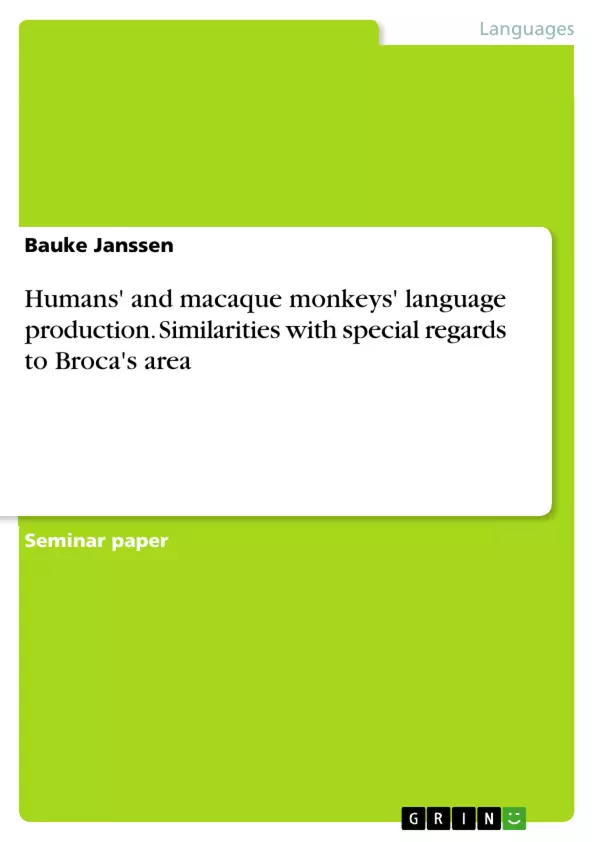This paper examines, whether apes share the same feature of the human language system with specials regards to Broca’s area.
The human language system is unique and allows our species to understand and verbally communicate with each other. It consists of complex syntax and semantics and is rooted deeply in the brain and specific areas. The speech area of the human brain is called Broca’s area .
Many neurologists and scientists did studies and researched the composition of the human and the monkey brain. Similarities as well as differences between the species were discovered which will demonstrate the relation between the human species and its early animal ancestors.
Inhaltsverzeichnis (Table of Contents)
- Introduction
- Language production in the human brain – Broca's area
- Broca's Area Homologue in monkeys
- Broca's area in the macaque monkey – Petrides' findings
- The mirror system hypothesis by Arbib & Rizzolatti
- Conclusion
Zielsetzung und Themenschwerpunkte (Objectives and Key Themes)
This paper aims to investigate the presence of similarities in language production between humans and apes, particularly focusing on Broca's area. It examines the structure and function of Broca's area in the human brain and explores the existence of a homologous area in monkeys. The paper further delves into the implications of these findings for our understanding of language evolution.
- The structure and function of Broca's area in the human brain
- The existence of a homologous area to Broca's area in monkeys
- The role of Broca's area in language production
- Similarities and differences in language production between humans and apes
- Implications for language evolution
Zusammenfassung der Kapitel (Chapter Summaries)
- Introduction: This chapter introduces the concept of human language and its uniqueness, emphasizing the role of Broca's area in speech production. It outlines the paper's objectives, which include investigating similarities between humans and apes in terms of language production and exploring the evolutionary aspects of language.
- Language production in the human brain – Broca's area: This chapter provides a detailed description of Broca's area, its location, and its subdivisions. It discusses the functions of different areas within Broca's region and explores the relationship between Broca's area and speech disorders such as aphasia and stuttering. The role of the FOXP2 gene in language development and its connection to Broca's area are also examined.
- Broca's Area Homologue in monkeys: This chapter delves into the existence of a homologous area to Broca's area in monkeys. It examines the findings of researchers like Petrides and Arbib & Rizzolatti, who have investigated the brains of macaques and other monkeys. The chapter explores the similarities and differences between the human and monkey brains in terms of language production and the implications for understanding the evolution of language.
Schlüsselwörter (Keywords)
Broca's area, language production, human brain, ape brain, macaque monkey, speech disorders, aphasia, stuttering, FOXP2 gene, language evolution, mirror system hypothesis, Petrides, Arbib & Rizzolatti.
- Citar trabajo
- Bauke Janssen (Autor), 2020, Humans' and macaque monkeys' language production. Similarities with special regards to Broca's area, Múnich, GRIN Verlag, https://www.grin.com/document/991570



